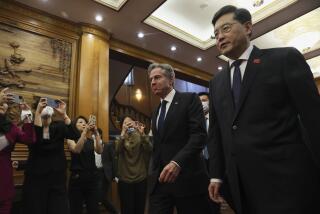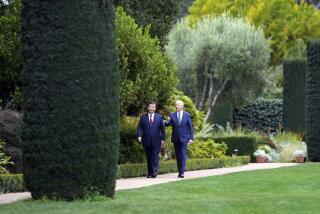Bush Strategy: An Odd Way of Treating Our Allies
Since China downed a U.S. reconnaissance plane in April, America’s China policy has regularly made front-page news. First came the negotiations for the return of the U.S. crew, followed by President George W. Bush’s attempt to clarify America’s position on Taiwan. Shortly afterward, the president’s new missile-defense blueprint prompted a harsh Chinese reaction. Very soon, the Pentagon will issue a new national strategy statement that places coping with China at the heart of U.S. defense planning. And very soon, the president will ask Congress to renew China’s trade privileges, a recurring exercise necessitated by Beijing’s failure to gain entry into the World Trade Organization.
The president believes that these measures add up to a clear and coherent, but nuanced strategy. As he summed up before the U.S. crew was released, the United States will treat China, if not as an enemy, then at least as a “strategic competitor.” He hastened to add, however, that he did not “mean that we can’t find areas in which we can partner. And the economy’s a place where we can partner.”
However unpopular opinion polls say this stance is with Americans, it has appeal in Washington. It sounds balanced and pragmatic, vigilant and hopeful, flexible yet firm. In short, it sounds like a policy that reflects the complexity both of China today and of America’s relations with Beijing.
In truth, the president’s approach is grounded not in nuance, but in incoherence.
If Washington wants to compete with China strategically, it will have to dramatically change its economic policies. Continuing to pursue today’s version of a Sino-American economic agenda can only fatally undermine America’s current security strategy in Asia.
China has made clear that it is competing with the United States for dominance in the region. Our current economic engagement with China is significantly strengthening Beijing’s hand .
China’s mammoth trade surpluses with the United States--which have grown from $10.4 billion in 1990 to $85 billion last year--represent a huge injection of hard currency into the Chinese economy. This trade pattern has enabled China not only to amass one of the world’s largest stocks of foreign currency reserves, but also to finance all of its major priorities.
Although not all of this growing annual windfall is spent on the military, trade-generated profits have made vast resources available to support Beijing’s foreign policy. Can it be coincidence that, shortly after running up a new record trade surplus with the United States, China announced an 18% increase in military spending? China’s estimated annual defense spending is roughly the same size as its trade surplus with the U.S.
Over the last decade, Beijing has bought a host of advanced weapons systems, including warships, strike aircraft, missiles and submarines from Russia and Europe. In the long term, however, it is the investment U.S. firms are making in China’s industrial base and strategic infrastructure that will tip the balance of power in Asia toward Beijing. With access to technology and know-how from both Russia and the West, China’s ability to build its own advanced aircraft, missiles and warships is steadily improving. And the focus of Beijing’s military modernization is clear; it is to project power outward toward the Pacific Rim directly at American interests and allies.
Current U.S.-China trade patterns are also weakening the regional allies that America needs to wage a successful strategic competition in Asia with the People’s Republic of China. Nothing has destabilized China’s Asian neighbors more than the financial crisis of 1997, which is still depressing regional economies. China was a major cause of the crisis; its currency devaluations in 1994 and 1996 made it much harder for other Asian developing countries to compete as exporters to the region’s biggest customer, the United States.
As a recent Business Week cover story on China reported, “China is fast becoming a manufacturing threat to many Asian countries.” This echoes Singapore’s Senior Minister Lee Kuan Yew, who warned in February that China’s growing trade “dominance” could put its neighbors out of business.
Since so many Asian countries had pinned their hopes for economic development on ever greater sales to America, heightened Chinese competition proved devastating, and global investors in countries like Thailand, Indonesia and South Korea rushed to get their money out once they realized that further export growth in these countries had become a pipe-dream.
China could not have surged ahead as its neighbors foundered had Washington not continued granting China most-favored nation-trading status throughout the 1990s. The unlimited market access China received not only crowded out the products of other Asian countries. It encouraged global investors to shift capital to the People’s Republic--where the brightest prospects for earning big returns involve exporting to the United States. The impact has been felt from South Korea to India, but particularly in Southeast Asia and Indonesia.
U.S. trade data make these trends clear. In 1992, America’s imports of goods from China represented 25% of its total goods imports from low-income Asia. By 2000, the Chinese share of these imports had grown to 36%. During the same period, Taiwan’s share fell from 23.9% to 14.6%, South Korea’s from 16.2% to 14.5%, Thailand’s from 7.3% to 3.9%, and Indonesia’s from 4.2% to 3.7%. Unless alternative markets emerge in Europe or Japan--a highly unlikely prospect--this trend will further reduce the economic growth of our allies and friends. Lower growth will undermine their creditworthiness, threaten their stability and further reduce their military spending.
There are even signs that Japan, whose security relationship with the United States is the linchpin of American strategy in Asia, may jump onto the China bandwagon in ways that hurt other Asian economies. The Tokyo Kyodo News Service reported April 20 that a draft 2001 white paper on international trade from the Ministry of Economy, Trade and Industry stressed the need to cooperate with China to build a new economic system in Asia, rather than continue competing with an ever more proficient People’s Republic. The proposed approach would give China’s developing neighbors roles to play, but envisions the People’s Republic as “the world’s production center” in a range of industries, including many in the high-tech sector.
China will undoubtedly use its economic weight to weaken U.S. influence in the region. Beijing already has used access to the China market to reward, punish or influence foreign firms and, less directly, their home governments. Just look at how Beijing has turned some of America’s largest businesses into a powerful latter-day China lobby that pushes Chinese positions not only on trade but on human rights, military sales to Taiwan, and many other noneconomic issues. Moreover, it is not hard to imagine Beijing trying to use commercial pressure on Japan or South Korea to discourage participation in a regional missile defense system, or to persuade Singapore to curtail the use of its ports by the U.S. Navy.
An administration commited to competing strategically in East Asia would be trying to check this Chinese economic momentum, not boost it. It would be trying to deny China precious resources, not shower the People’s Republic with cash and technology. New trade policies are the keys to implementing this strategy. Since virtually everything the United States imports from China can easily be produced elsewhere in Asia, Washington should be pressing American and Asian business interests alike to shift their export-oriented investments out of an increasingly threatening China and into friendlier, less militarily formidable countries. Trade preferences for these countries’ goods at China’s expense would give these urgings real substance.
New trade and investment flows alone can’t restore stability to shaky countries like Indonesia and the Philippines, but they could prevent or slow further deterioration. Moreover, such trade and investment shifts could make a real difference for countries like South Korea, Taiwan, and Thailand.
Where the strategic stakes are high, economic activity inevitably produces political-military consequences. For a president who has said he would do “whatever it took to help Taiwan defend herself,” favoring friends over avowed rivals in Asian economic policy is the least that can be done to maintain an advantageous balance of power along the Pacific Rim.
More to Read
Start your day right
Sign up for Essential California for news, features and recommendations from the L.A. Times and beyond in your inbox six days a week.
You may occasionally receive promotional content from the Los Angeles Times.





